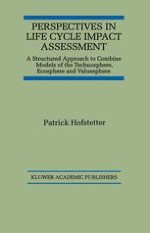Perspectives in Life Cycle Impact Assessment: A Structured Approach to Combine Models of the Technosphere, Ecosphere and Valuesphere describes the relationship between subjective and objective elements in Life Cycle Impact Assessment. It suggests a new framework which will allow people to master two of the major problems associated with LCA, the difficulty of separating subjective from objective elements and the tendency for impact assessment to record `phantoms' rather than actual damages.
Perspectives in Life Cycle Impact Assessment: A Structured Approach to Combine Models of the Technosphere, Ecosphere and Valuesphere presents a proposal for a second generation framework and method for Life Cycle Impact Assessment. Many of the suggested elements are either based on other tools for environmental analysis, e.g. risk assessment, or fit in well with tools and concepts such as industrial ecology, technology assessment, or environmental impact assessment. The research presented in this book goes beyond the scope of presently used methods for Life Cycle Assessment and may stimulate new developments in a variety of areas.
The book will appeal to persons from a wide range of scientific disciplines who are interested in learning more about Life Cycle Assessment. It will be especially valuable to members of SETAC and to students and researchers in the fields of environmental impact assessment, risk assessment and industrial ecology.
